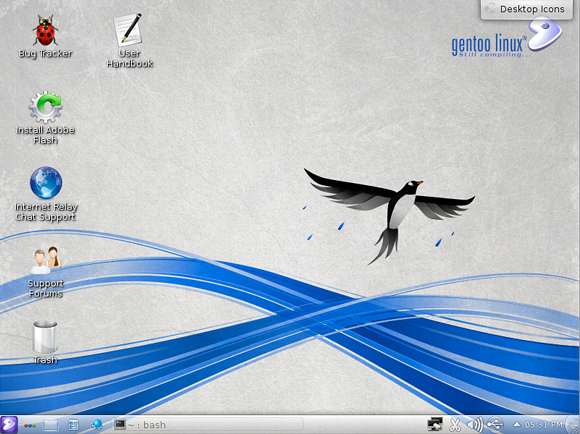How to Install Easy-Way for Linux Gentoo 2012.1 Amd64 KDE4 desktop to Hard-Drive from the LiveDVD Hybrid x86-amd64 Release.
And this Visual Guide includes the Basic Screenshots of All GUI Steps involved.
The content and details are expressly reduced to give Focus only to the Essentials Instructions and Commands and Make the Tut Easier to Understand ;)

-
Download Gentoo 12.1 x86-amd64:
Gentoo 12.1 Hybrid Release -
Boot from Gentoo 12.1 Hybrid LiveDVD
-
Disk Partitioning.
sudo su
If Got “User is Not in Sudoers file” then see: How to Enable sudo
parted /dev/sda
(parted)
mklabel msdos
Making an extf2 /boot Partition of 256mb
(parted)mkpart primary ext2 0 256mb
When Prompted About Partition Allignment Just Answer ‘i’ for Ignore.
Creating a Swap Partition of 1Gb
(parted)mkpart primary linux-swap 256mb 1276mb
Making an ext3 Root Partition the Rest of Disk
(parted)mkpart primary ext3 1276mb -1s
Then Quit parted:
quit
-
Applying File Systems to Partitions
Apply the extf2 File System to /boot Partition.
mkfs.ext2 /dev/sda1
Create and Activate the Swap.
mkswap /dev/sda2
swapon /dev/sda2
Apply the extf3 File System to /Root Partition.
mkfs.ext3 /dev/sda3
After the Partitions are Rightly Initialized and Housing a File System :)
-
Mounting Base Partitions
mount /dev/sda3 /mnt/gentoo
mkdir /mnt/gentoo/boot
mount /dev/sda1 /mnt/gentoo/boot
-
Copy LiveDVD to Hard-Drive
eval `grep '^ROOT_' /usr/share/genkernel/defaults/initrd.defaults`
cd /
cp -avx /$ROOT_LINKS /mnt/gentoo
If you Get a Warning About emule Missing Just Ignore and Follow to Next Step :)
cp -avx /$ROOT_TREES /mnt/gentoo
cp /etc/passwd /etc/group /mnt/gentoo/etc
-
Mounting File Systems and Entering the New Environment
-
Configuring the fstab File
nano -w /etc/fstab
Now if you Replicated the Partitioning Details you will Need to Insert:
/dev/sda1 /boot ext2 defaults,noatime 1 2 /dev/sda2 none swap sw 0 0 /dev/sda3 / ext3 noatime 0 1 /dev/cdrom /mnt/cdrom auto noauto,user 0 0 proc /proc proc defaults 0 0 shm /dev/shm tmpfs nodev,nosuid,noexec 0 0
-
Copy Kernel and Initramfs into /boot Partition
mkdir -p /mnt/cdrom/
Mount the LiveDVD into /mnt/cdrom.
mount /dev/cdrom /mnt/cdrom/
Copying the Kernel.
cp /mnt/cdrom/boot/gentoo64 /boot/kernel64
Copying the Initramfs.
cp /mnt/cdrom/boot/gentoo64.igz /boot/initramfs64
-
Configuring and Installing GRUB
Make the grub Configuration File.
nano -w /boot/grub/grub.conf
Insert.
default 0 timeout 31 title Gentoo Linux Amd64 root (hd0,0) kernel /boot/kernel64 real_root=/dev/sda3 /ninitrd /boot/initramfs64
Grub Set-Up.
grub
grub> root (hd0,0)
grub> setup (hd0)
grub> quit
-
Latest to Prevent Linux Gentoo Booting Issues Apply:
Linux Gentoo Article-Installation Activation -
Finally, you Can Boot Into Linux Gentoo 12.1 KDE4 desktop :)
mkdir /mnt/gentoo/proc /mnt/gentoo/dev
cd /mnt/gentoo/dev
mknod -m 660 console c 5 1
mknod -m 660 null c 1 3
mount -t proc none /mnt/gentoo/proc
mount -o bind /dev /mnt/gentoo/dev
mkdir /mnt/gentoo/sys
Now is Time to Entering the New Environment :)
chroot /mnt/gentoo /bin/bash
If for some Reason you Need to Come Back to the Original Environement Execute ‘exit’ or Type ‘Ctrl-d’…
Updating you New-Environment.
env-update && source /etc/profile
Latest Remove the autoconfig from default boot to Keep Password Setting over Reboot.
rc-update del autoconfig default
